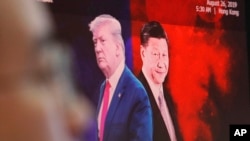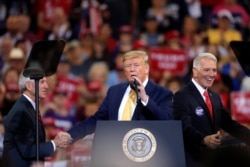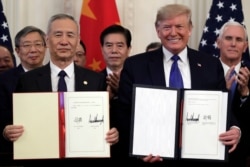After 18 months of a tit-for-tat tariff-driven trade war, China and the United States have emerged with a truce in the form of the first phase of a trade deal, and a victory for both sides.
Conversations among business leaders at the World Economic Forum Annual Meeting in Davos, Switzerland suggested there may not be a phase two of the deal until after the U.S. election in November, echoing what President Donald Trump said before phase one was signed.
Yet that agreement, signed January 15, offers the prospect of some economic stability, a win for Trump and a win China’s President Xi Jinping.
Even before a new coronavirus reached crises levels in China, Xi was facing a slowing economy, which was not helped by the trade war, a persistent pro-democracy movement in Hong Kong, and the embarrassing reelection of Taiwan’s anti-Beijing president, Tsai Ing-Wen, on January 11. Beijing considers Taiwan an island province — Xi has called reunification “inevitable” — but the Republic of China, as it is officially known, has been separate from the People's Republic of China since 1949. Taiwan has its own government democratically elected by citizens increasingly wary of China’s growing rising authoritarianism.
For Trump, the trade truce offers a distraction from a Senate impeachment trial. He was trumpeting the deal even before it was signed, telling a Lake Charles, Louisiana rally on October 11 that farmers would need more land and bigger tractors to cope with demand from China.
The deal commits Beijing to increasing its imports of U.S. manufacturing, energy and farm goods by $200 billion this year and next. That includes larger purchases of soybeans and other farm goods expected to reach $40 billion a year, although some critics wonder if China can meet the targets.
While Xi and Trump each needed a win, the on-the-street feeling in Beijing is that Trump was more eager to reach a deal. Online commentators pointed to the power imbalance between the signatories. Xi’s top economic aide, Vice Premier Liu He, signed the trade agreement with Trump. Others suggested the deal embarrassed Xi, who wanted to distance himself from the agreement.
Before the signing, the White House soft-pedaled Xi’s absence. An administration official said that “the ceremony taking place on U.S. soil is a victory in and of itself, and that a future meeting between the two leaders is still a possibility," according to ABC News.
"President Trump needs the truce for political reasons,” said Edward Alden, a trade expert with the Council on Foreign Relations. “The trade war with China has created a lot of uncertainty in the U.S. financial markets. … Going into the 2020 campaign, President Trump wants the financial markets to be quiet and happy.”
Signing phase one could boost Trump’s reelection chances because the president can claim that he is “a good dealmaker” at campaign rallies, said Alden.
"I actually do think that it’s going to help him in the 2020 election. It’s one of the few examples in his presidency so far where he can show significant concrete results. He came to the presidency saying that he is a good dealmaker,” said Alden. “He hasn’t actually made so many deals. Mostly, what he has done is basically rip up the deals the previous president made.”
On Sunday, Trump addressed the American Farm Bureau Federation's convention about the new U.S. trade agreements. “We did it,” Trump said in Austin, Texas as he recalled his campaign promises to improve trade with China and separately with Canada and Mexico, a deal also signed last week.
Trump fired the first salvo of the trade war in March 2018, setting tariffs on China with an effort to change what the U.S. called "unfair trade practices" such as a growing trade deficit, the theft of intellectual property and the forced transfer of American technology to China.
At the signing ceremony, Trump said that China would buy agricultural products worth $40 to $50 billion over the next two years, as much as double the pre-trade war values.
According to data from the United States Department of Agriculture (USDA), net agricultural income in the United States hit a record high of $ 123.4 billion in 2013. By 2018, that net income was expected to fall to $59.5 billion, a 12-year low, according to USDA Economic Research Service’s Farm Sector Income Forecast, and if realized, a decline of 6.7 percent from the USDA’s 2017 projection. By 2019, net agricultural income had fallen to $55.5 billion.
The Trump administration allocated $28 billion to help farmers in 2018 and 2019 but the subsidies have not completely offset losses even though payments to farmers have exceeded what Detroit’s Big Three automakers received in the 2009 bailout, which cost taxpayers $12 billion.
Chad Bown of the Peterson Institute for International Economics told VOA that having a signed deal is better for both leaders than continuing escalation of the trade war “and things getting worse and worse, I do think this is better than that.”
Alden said that although the U.S. requested inclusion of structural reforms such as Beijing’s subsidies to state-owned enterprises, and support and subsidies to the emerging industries, China won by having shifted that issue to the next stage.
"China was successful in two respects. The deal provided a truce from the trade ware, which is what China very much wanted,” said Alden. He added that it was more significant that, “on the core issues [of structural reforms], China refused what the U.S. was demanding.”
Many analysts have pointed out that the deal is "asymmetric," favoring the U.S. because “China shall” appears often throughout the agreement.
Bown said, “Many of the commitments that China seems to be willing to take on in this agreement, I think, arguably, are actually good for China. … So it isn’t just one-sided.”
CFR’s Alden said that China reached the agreement for economic reasons.
"The trade war has clearly done some harm to the Chinese economy, [more] than what it did on the US economy,” he said. “For economic reasons, China needs the truce.”
Huang Yiping, deputy dean of the National Development Research Institute of Peking University, said in an interview with VOA on January 10 that the significance of the agreement lies in the fact that it provides a truce to the trade war, ending economic uncertainty for both countries.
"The trade war has a relatively huge impact on China,” Huang said. “The biggest impact is the uncertainty of the policy, especially when the two sides are always at war. As a Chinese entrepreneur, I don’t know what the tariff rate will be in the future and that will affect their investment plans. … The investments on both sides are declining, and I personally think it is related to the trade war.”
"The second impact is more direct,” Huang continued. “Yes, your increased tariffs [are] not conducive to my exports, which will affect the economy. The growth rate of our exports in the nominal value last year fell by 10%."
China's GDP grew by 6.1 per cent last year, the slowest rate in 29 years, the government said earlier this month. According to forecasts in an International Monetary Fund report, the growth rate will slip below 6.0% in 2020.
Bill Bishop, writer of the China-focused newsletter Sinocism said “I think President Xi … is happy with a truce that doesn’t require China to give up too much. I’m not sure he needed the deal as much as Trump did. I think for both of them, [it’s] better to have even a small bad deal than no deal at all at this point. And that’s where we ended up.”














